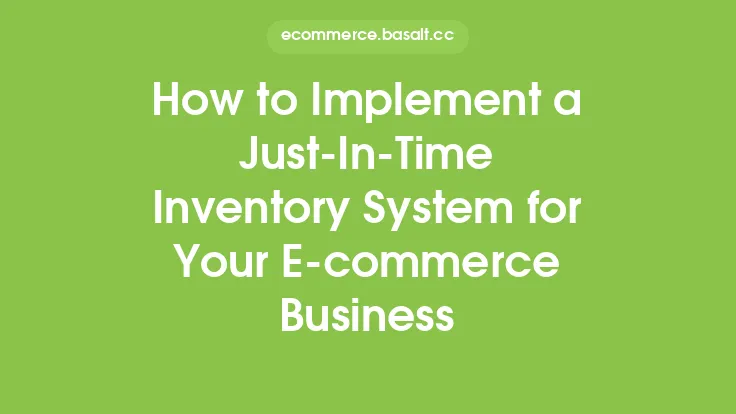Implementing a just-in-time (JIT) inventory system is a strategic approach that can help e-commerce businesses optimize their inventory management, reduce costs, and improve customer satisfaction. A JIT inventory system is designed to maintain minimal inventory levels, ordering and receiving inventory just in time to meet customer demand. This approach requires careful planning, coordination, and execution to ensure that the right products are available at the right time.
Understanding the Basics of Just-In-Time Inventory Systems
A JIT inventory system is based on the principle of producing and delivering products just in time to meet customer demand. This approach aims to minimize inventory levels, reduce waste, and optimize production processes. In the context of e-commerce, a JIT inventory system involves ordering and receiving inventory from suppliers just in time to fulfill customer orders. This approach requires close collaboration with suppliers, accurate demand forecasting, and efficient logistics management.
Benefits of Implementing a Just-In-Time Inventory System
Implementing a JIT inventory system can bring several benefits to e-commerce businesses, including:
- Reduced inventory holding costs: By maintaining minimal inventory levels, businesses can reduce the costs associated with storing and managing inventory.
- Improved cash flow: JIT inventory systems can help businesses free up cash that would otherwise be tied up in inventory, allowing them to invest in other areas of the business.
- Increased efficiency: JIT inventory systems can help businesses streamline their operations, reduce waste, and improve productivity.
- Better customer service: By ensuring that products are available when customers need them, businesses can improve customer satisfaction and loyalty.
- Reduced risk of obsolescence: JIT inventory systems can help businesses avoid holding inventory that may become obsolete or go out of style.
Key Components of a Just-In-Time Inventory System
A JIT inventory system consists of several key components, including:
- Demand forecasting: Accurate demand forecasting is critical to ensuring that the right products are available at the right time.
- Supplier collaboration: Close collaboration with suppliers is essential to ensuring that inventory is delivered just in time to meet customer demand.
- Inventory management software: Inventory management software can help businesses track inventory levels, monitor demand, and optimize inventory ordering.
- Logistics management: Efficient logistics management is critical to ensuring that inventory is delivered quickly and efficiently.
Implementing a Just-In-Time Inventory System
Implementing a JIT inventory system requires careful planning and execution. The following steps can help businesses implement a JIT inventory system:
- Analyze demand patterns: Businesses should analyze historical demand patterns to identify trends and seasonality.
- Collaborate with suppliers: Businesses should work closely with suppliers to ensure that they can deliver inventory just in time to meet customer demand.
- Implement inventory management software: Businesses should implement inventory management software to track inventory levels, monitor demand, and optimize inventory ordering.
- Develop a logistics strategy: Businesses should develop a logistics strategy that ensures inventory is delivered quickly and efficiently.
Challenges and Limitations of Just-In-Time Inventory Systems
While JIT inventory systems can bring several benefits to e-commerce businesses, there are also several challenges and limitations to consider, including:
- Dependence on suppliers: JIT inventory systems rely heavily on suppliers to deliver inventory just in time to meet customer demand.
- Risk of stockouts: If demand is higher than expected, businesses may experience stockouts, which can lead to lost sales and damaged customer relationships.
- Complexity: JIT inventory systems can be complex to implement and manage, requiring significant resources and expertise.
- Limited flexibility: JIT inventory systems can limit a business's ability to respond to changes in demand or supply chain disruptions.
Best Practices for Managing a Just-In-Time Inventory System
To ensure the success of a JIT inventory system, businesses should follow several best practices, including:
- Monitor demand closely: Businesses should continuously monitor demand to ensure that inventory levels are optimized.
- Collaborate with suppliers: Businesses should work closely with suppliers to ensure that inventory is delivered just in time to meet customer demand.
- Use inventory management software: Businesses should use inventory management software to track inventory levels, monitor demand, and optimize inventory ordering.
- Develop a contingency plan: Businesses should develop a contingency plan to address potential stockouts or supply chain disruptions.
Conclusion
Implementing a JIT inventory system can help e-commerce businesses optimize their inventory management, reduce costs, and improve customer satisfaction. By understanding the basics of JIT inventory systems, benefits, key components, implementation steps, challenges, and best practices, businesses can make informed decisions about whether a JIT inventory system is right for their business. With careful planning, execution, and management, a JIT inventory system can help businesses achieve their goals and stay competitive in the e-commerce market.





